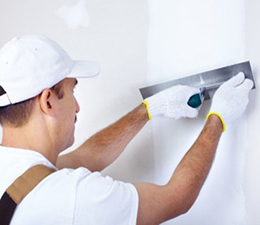Plastering The Walls & Ceilings in Your Home
Clea plaster can help to fix a multitude of sins in your home. Walls can crack and become easily damaged, especially with family homes or rental properties. Ceilings can do the same, this is especially the case with older properties who have boards in the ceilings that have not been joined properly and have not been fully bonded – the ceiling can sag, crack and chip when the boards begin to settle.
plaster can help to fix a multitude of sins in your home. Walls can crack and become easily damaged, especially with family homes or rental properties. Ceilings can do the same, this is especially the case with older properties who have boards in the ceilings that have not been joined properly and have not been fully bonded – the ceiling can sag, crack and chip when the boards begin to settle.
The other reason homeowners have areas re-plastered or skimmed is when artex is currently in place – it is dated and most modern homes prefer ceilings to be skimmed to a smooth finish. Another reason? When walls have become damp, they can be re-plastered when the damp source has been located and repaired.
Re-plastering
This is a great way to modernise the home. Consider whether your walls are slightly out of shape, as a plasterer will not always be able to complete the plastering work to a straight finish without re-boarding and bonding (re-floating) the entire wall again – basically, starting from scratch is sometimes the only way to correct the problem. Some homeowners, however, are happy to simply carry out repair works on such walls to save money though its important to get advice from the plasterer to ensure that they can guarantee problems won’t occur again. In this case re-skimming existing walls may be the solution.
It may be that you prefer only the damaged areas or cracks to be filled in, in this case its important to ensure that the cracks won’t re-occur and that you are sure cracks are not a sign of more serious damage other than old, dry plasterwork. Modern plaster or mortar applied to older walls may cause defectiveness. Another thing to mention is that it’s essential to ensure if the wall is an exterior one, that the mortar or cement in the bricks or stones (if you house is of traditional build) is intact.
If the walls are already very smooth, it can be vital that the plasterer you undertake to carry out work cracks the current plaster so that the new plaster can attach itself permanently.
Re-skimming
If the existing skimming on your walls or ceiling has become flaky with no hollowing in the wall cavity, it may be possible to bond the existing boards to level the entire wall or ceiling up. This is especially the case where any cracks or flakes cannot be plastered over. In many cases it is possible for a plasterer to re-skim over old materials. In some cases, you can fill in smaller cracks yourself though do be prepared to re-paint or wallpaper the entire room.
The main difference between re-plastering (or skimming) and plastering over plasterboard is in the preparation. Such prep must be carried out properly or new plaster will not take as the existing plaster has a high rate of suction capability, meaning that new plaster can be absorbed too quickly and will cause problems.
Damaged plasterboard whether on walls or ceilings needs to be repaired first before attempting re-skimming (or re-plastering.) PVA is usually applied to old plaster before new plaster is used to skim the area, this prepares the area and prevents the existing plaster from sucking in the new.
A re-skim can be up to £10 per square metre depending on your location, however having advice from a professional is helpful at this point.
Conclusion
Assess the room and the exterior facing walls for concealed sources of the problem. Smaller cracks may be simply that your home is older and boards have settled over time, that they weren’t fitted properly to begin with, or that the plaster has simply become damp or dry over time.
Comments Off on Plastering The Walls & Ceilings in Your Home



Comments are closed